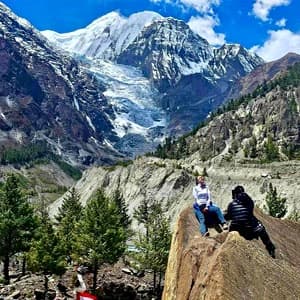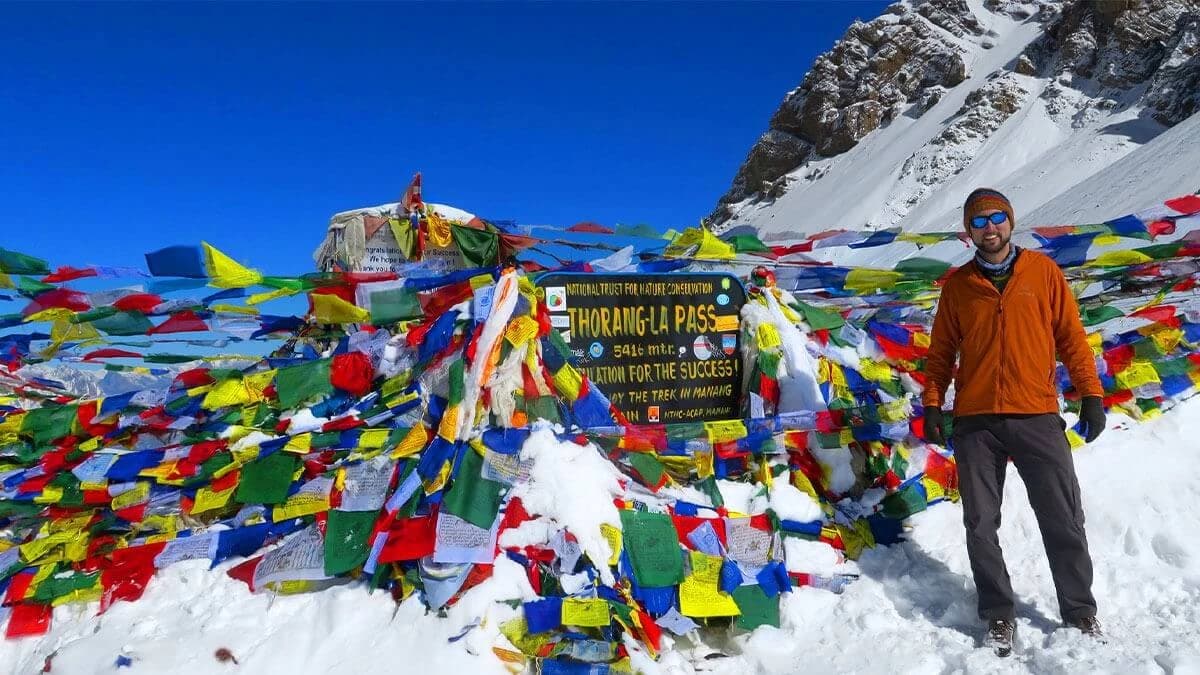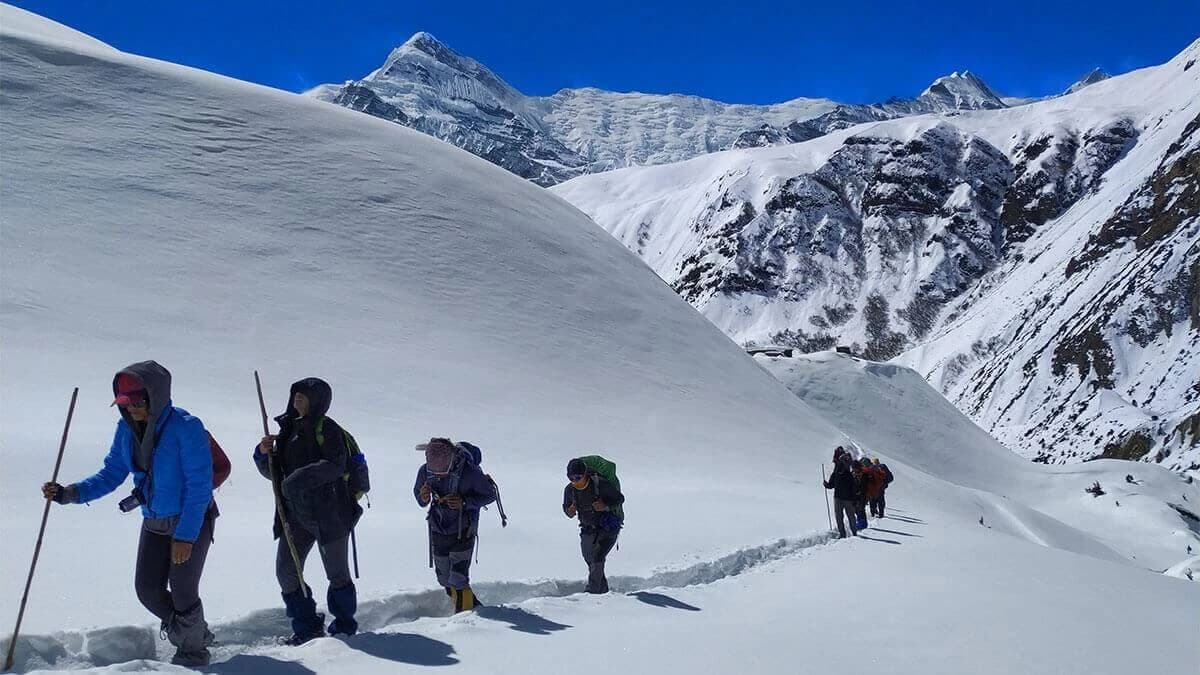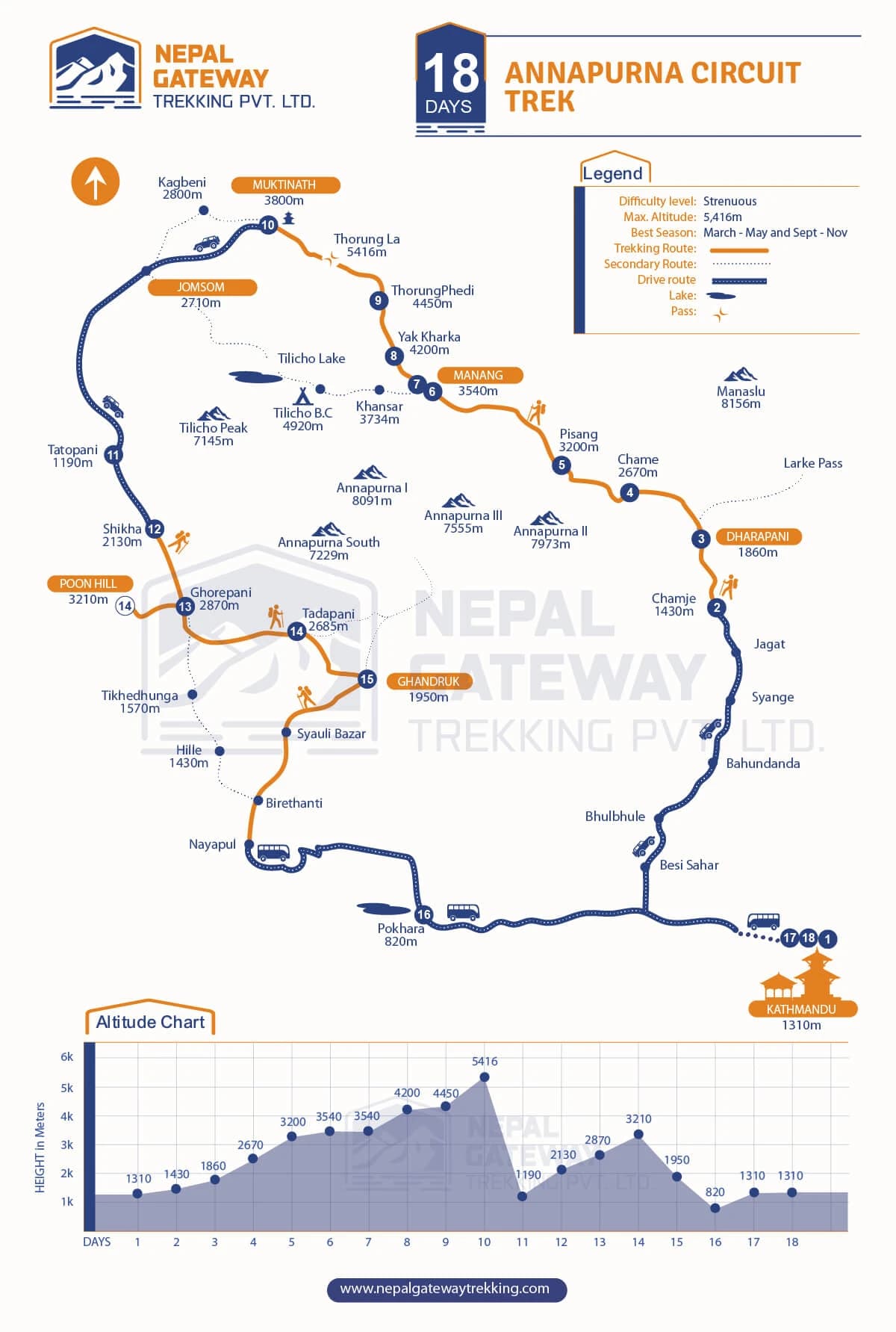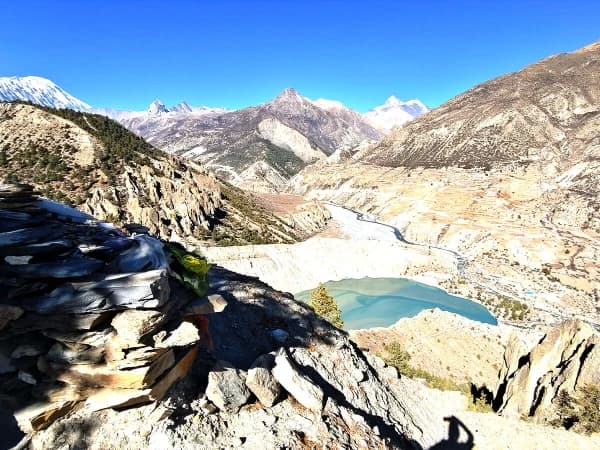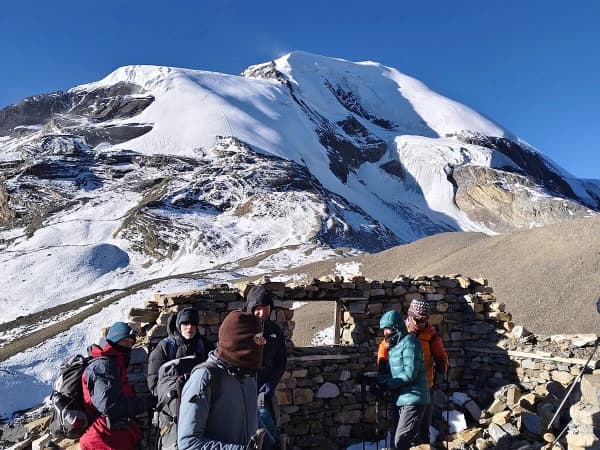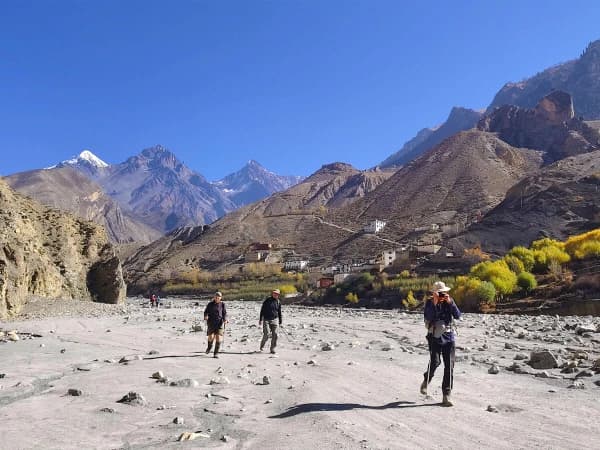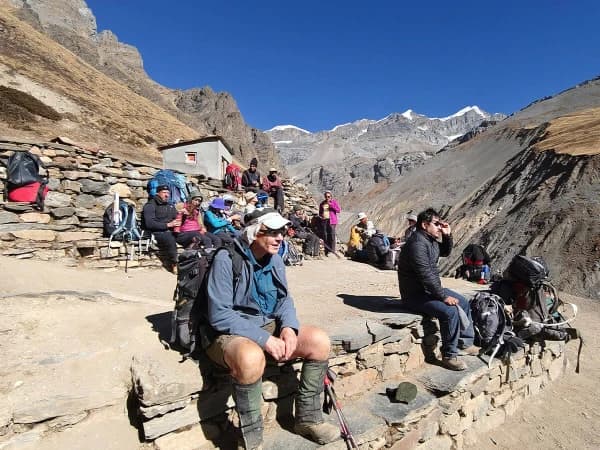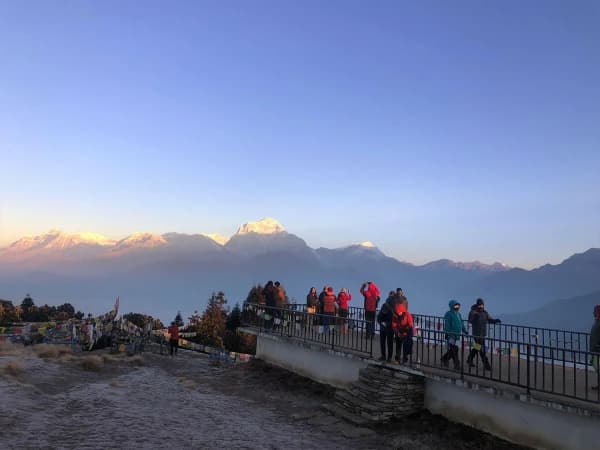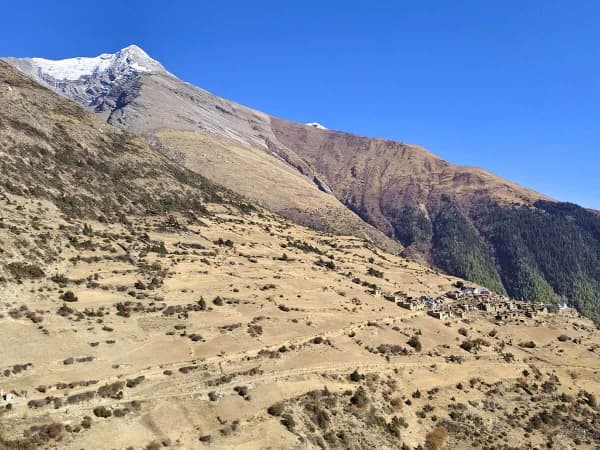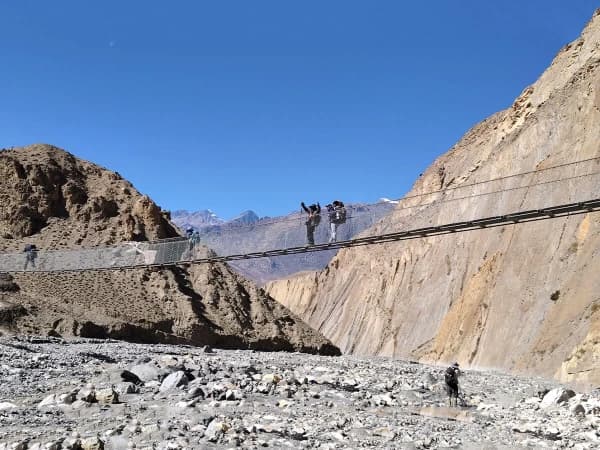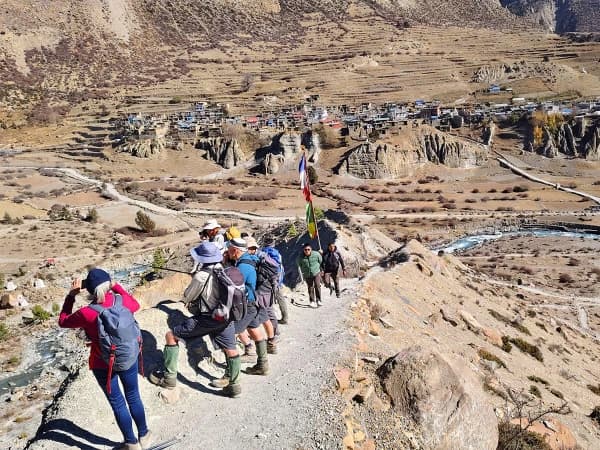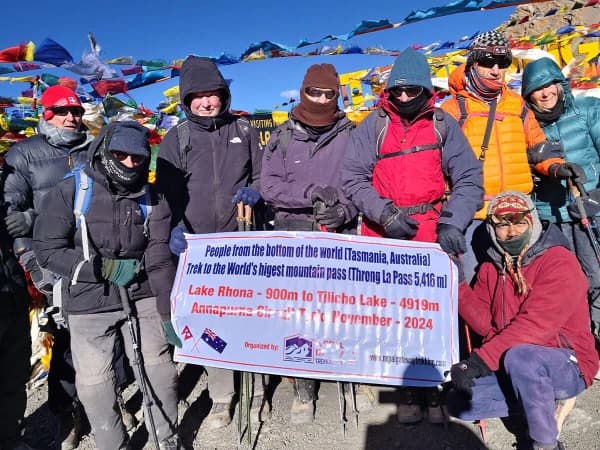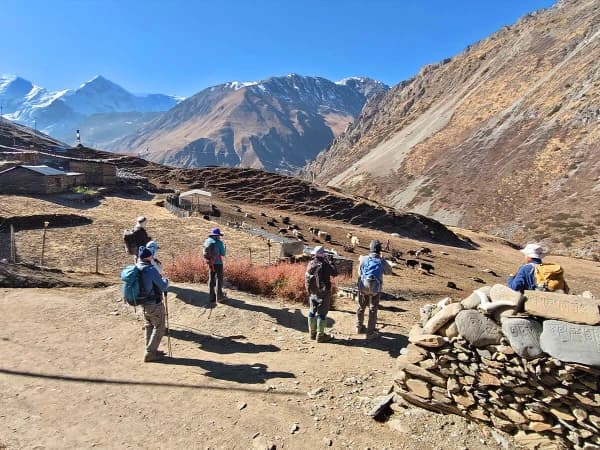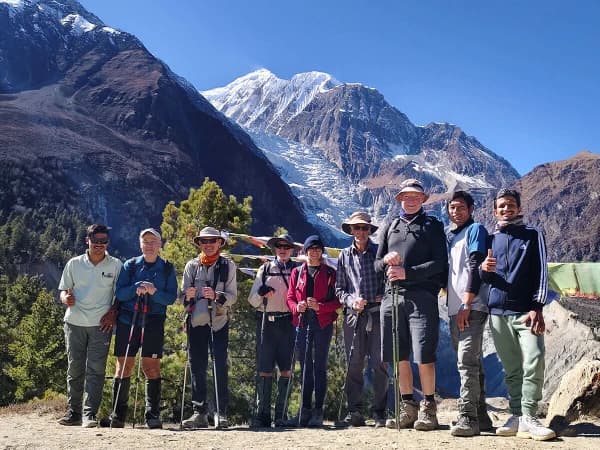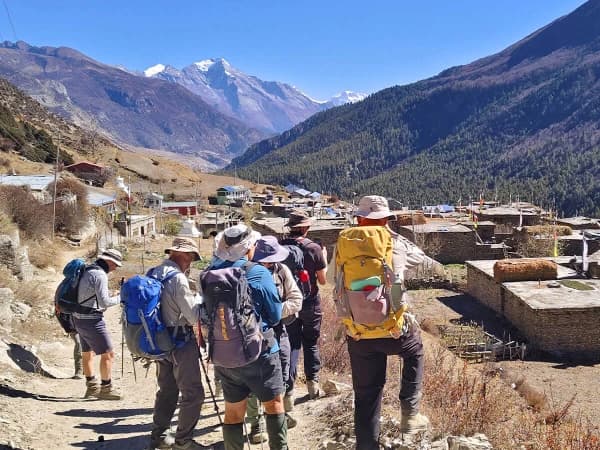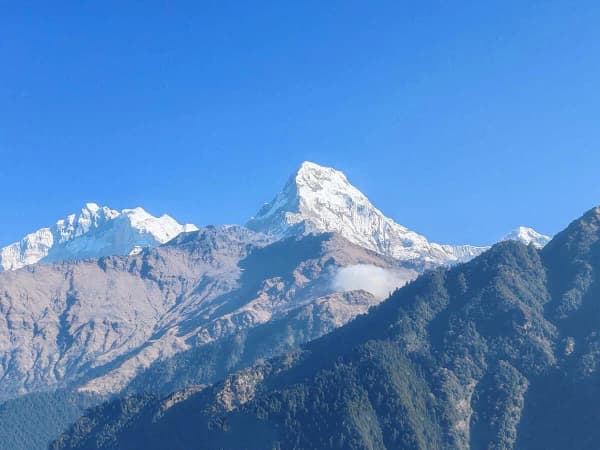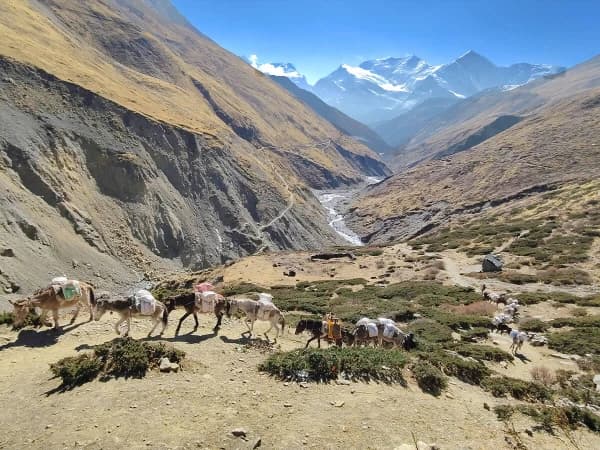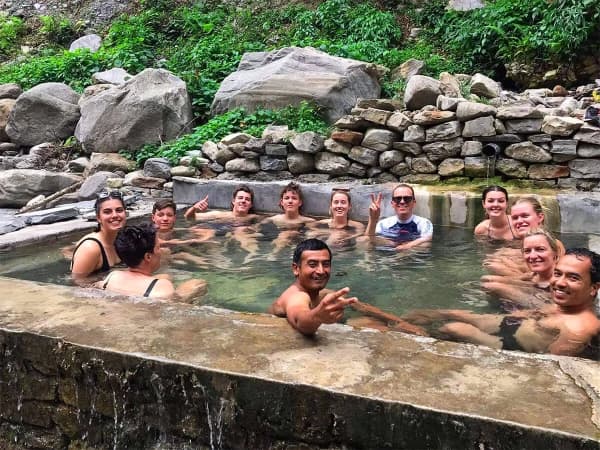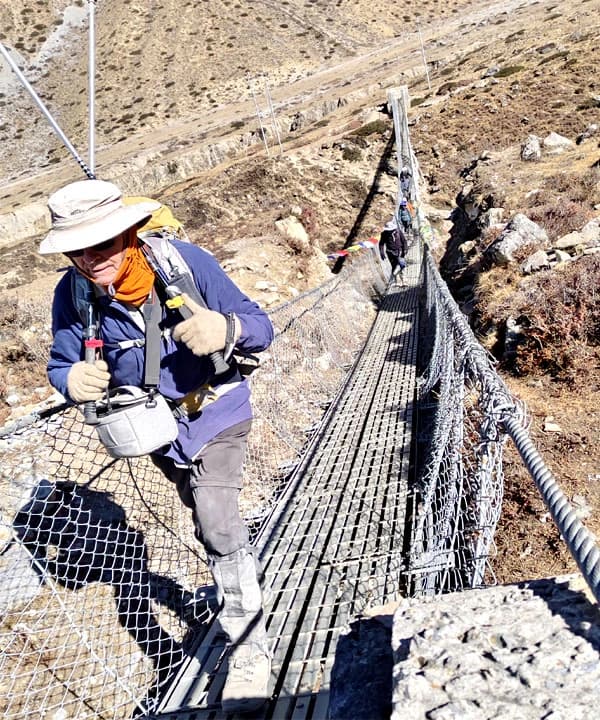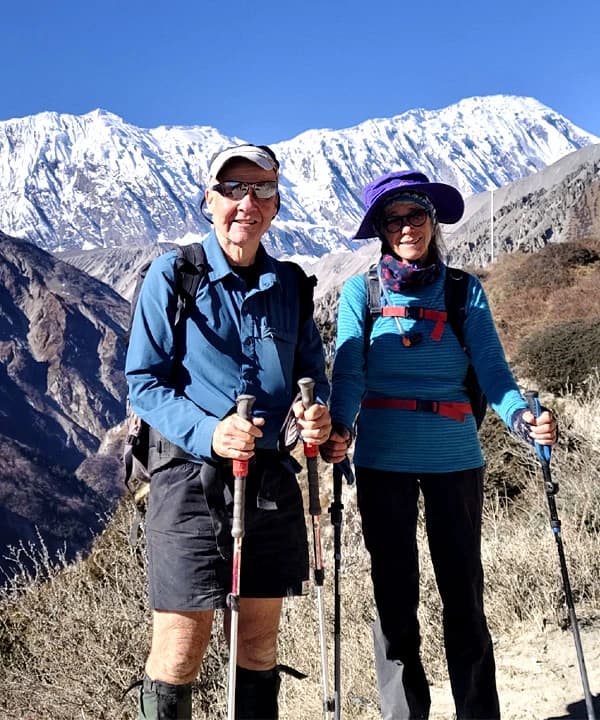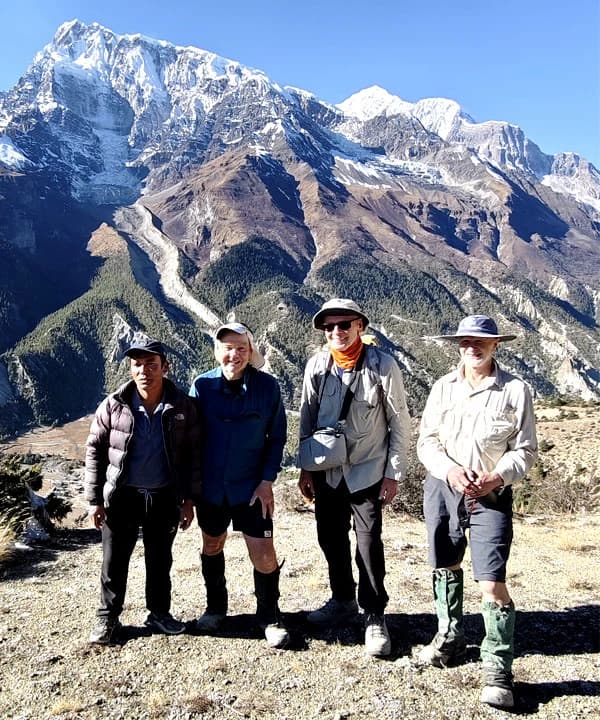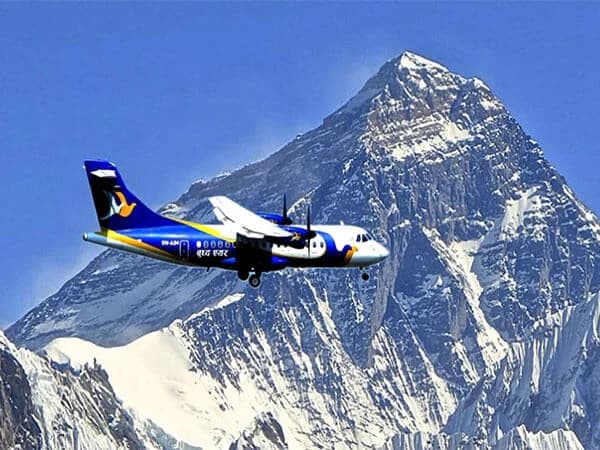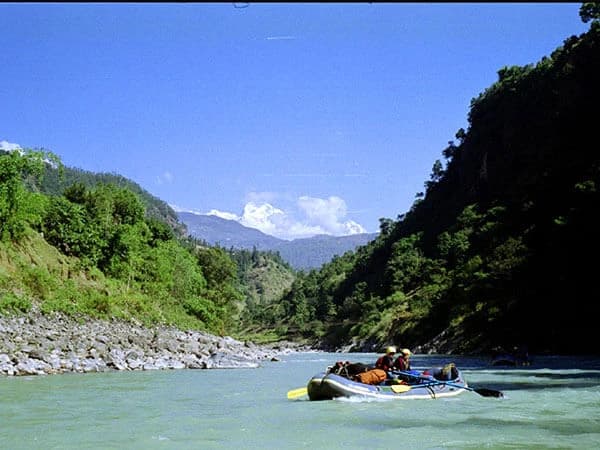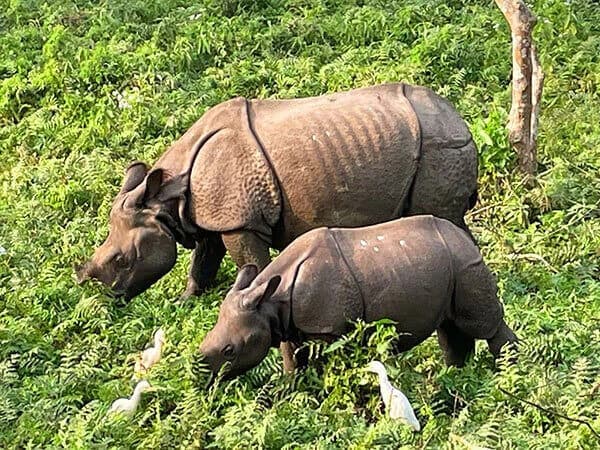The Annapurna Circuit Trek is the ultimate trek in the Annapurna region, crossing over Thorong La Pass (5,416 m). The trek route is well-known for its breathtaking panoramic views of the majestic Himalayas of Annapurna and spectacular landscapes.
Annapurna Circuit Trek
Annapurna Circuit Trek is one of Nepal's most celebrated long-distance trekking routes. It circles the entire Annapurna Mountain range over 18 days of adventure. This circuit trek is famous worldwide for crossing the challenging Thorong La Pass at 5,416 meters. Our 18-day Annapurna Circuit trek package combines the main Annapurna Circuit with the Ghorepani Poon Hill trekking experience. This unique combination offers trekkers both high-altitude adventure and panoramic sunrise views from Poon Hill.
The Annapurna region opened to foreign trekkers in 1977. Before this, the area remained restricted and untouched by tourism. Local people used ancient trade routes through these mountains for centuries. The circuit became popular after Maurice Herzog's 1950 Annapurna expedition. Gradually, tea houses developed along the trail to support the growing number of international visitors. The route transformed from a remote wilderness path into a well-established trekking circuit.
The Annapurna Circuit trail passes through diverse ethnic communities with rich cultural traditions. Gurung, Magar, and Thakali inhabit the lower regions with unique customs. Higher up, Tibetan Buddhist communities, such as the Manangis, preserve ancient mountain culture. Their monasteries, prayer flags, and traditional stone houses dot the landscape. Visitors experience warm hospitality and learn about centuries-old farming and trading practices. Each village offers insights into different ways of mountain life.
The Annapurna Conservation Area protects incredible biodiversity across varied ecosystems. Dense rhododendron forests bloom spectacularly in spring. Wildlife includes blue sheep, snow leopards, and over 100 bird species. The area spans from tropical valleys to alpine meadows and barren high-altitude terrain.
This 18-day Annapurna Circuit trek itinerary combines natural beauty, cultural immersion, and physical challenge. It offers one of the world's most complete Himalayan experiences in a single journey.
Major Highlights of Annapurna Circuit Trek
- Trek through the world's deepest Kali Gandaki Gorge, carved between the Annapurna and Dhaulagiri mountains.
- Experience dramatic terrain changes from subtropical lowlands to high alpine meadows within the Annapurna Conservation Area.
- Conquer the challenging 5,416m Thorong La Pass, the trek's most thrilling achievement.
- Explore acclimatization options like Gangapurna Lake, Ice Lake (Kicho Tal), Parken Gompa, or Braga Monastery.
- Experience authentic Tibetan lifestyle in traditional villages like Pisang, Manang, Braga, Ghara, and Ngawal.
- Visit the sacred Muktinath temple featuring 108 waterspouts and eternal flames revered by Hindus and Buddhists.
- Witness impressive views of Annapurna I, II, III, IV, Dhaulagiri, Machhapuchhare, Hiunchuli, Tilicho Peak, and Lamjung Himal.
- Experience the magical sunrise over the Annapurnaesque hamlets like Ghandruk along the Poon Hill route.
- Enjoy unique views throughout the entire circuit loop without retracing your steps.
Route Overview of Annapurna Circuit
The Annapurna Circuit route is one of Nepal's most outstanding trekking routes, offering a complete loop around the majestic Annapurna mountains. Unlike other base camp treks in Nepal, the Annapurna Circuit trail ensures you never see the same scenes twice as you traverse this incredible circular journey. This trek typically begins in the subtropical municipality of Chamje. It concludes in the beautiful lakeside city of Pokhara, making it perfect for trekkers seeking diverse landscapes and cultural experiences.
Usually hiked anti-clockwise for better acclimatization, the trek begins in Kathmandu with a drive to Chamje via Besisahar. From there, the trail passes through Dharapani (first ACAP checkpoint) and villages like Chame, Timang, Pisang, and Ngawal, before reaching Manang. Although Manang is accessible by road, trekkers prefer to hike in for proper acclimatization. The trail follows the Marshyangdi River, showcasing stunning views of Annapurna and Dhaulagiri.
Manang offers important acclimatization hikes such as Parken Gompa and Ice Lake. After resting, the trek continues to Yak Kharka and Thorong Phedi, base for the challenging Thorong La Pass at 5,416 meters. The steep climb before dawn rewards you with breathtaking panoramic views.
Crossing into Mustang, the trail descends to Muktinath Temple, a sacred pilgrimage site with 108 waterspouts and eternal flames. The trek then goes through Jomsom and Tatopani, where natural hot springs provide a welcome rest.
Next, the route leads to the Ghorepani Poon Hill trek, passing Thakali villages like Shikha. The early morning trek to Poon Hill offers spectacular sunrise views of Annapurna and Dhaulagiri.
In the final days, you’ll pass through Tadapani and Banthanti before reaching the charming Gurung village of Ghandruk, famous for its traditional stone houses and stunning mountain views. From there, the trek winds down to Nayapul, where you’ll catch a drive to Pokhara—a perfect spot to relax and celebrate completing this unforgettable journey.
What Makes the Annapurna Circuit Trek Unique in 2025?
In 2025, the Annapurna Circuit beautifully blends its timeless, rugged charm with thoughtful modern improvements. Thanks to the efforts of the Annapurna Conservation Area Project (ACAP) and local communities, the trail is now easier to navigate and more eco-friendly, offering trekkers a smoother journey without losing any of the authentic mountain adventure.
One of the biggest enhancements is the expansion of the New Annapurna Trekking Trails (NATT)—detours that steer hikers away from the motorable roads. These other routes not only recreate the original trekking experience, but also protect the untouched Himalayan landscape that the Circuit is known for.
What’s new in 2026?
- Improved trails and signage: Wayfinding is now easier, even in remote areas. Eco-friendly signs and better-maintained paths make navigation and safety more efficient.
- Teahouse upgrades: Many guesthouses have been renovated with solar-powered amenities, clean bathrooms, and hygienic dining setups. In popular villages like Manang, Chame, and Muktinath, modern facilities now blend with traditional Nepali warmth.
- Mandatory guides: Since 2023, trekkers must hike with licensed guides—an important safety measure that also supports local employment and sustainable tourism.
Despite its rising popularity—with ACAP recording over 244,000 trekkers in 2024—the Annapurna Circuit still offers peaceful trails, especially during the off-season (December–February). What you spend on permits and tourism fees does more than just grant you trail access—it directly supports reforestation, builds schools, improves drinking water, and funds waste management in the villages you pass through. It’s a simple way your journey gives back.
By 2065, the Annapurna Circuit isn’t just better maintained—it feels more in tune with nature and the people who live there. For today’s trekkers looking for a truly meaningful adventure, this classic trail offers a deeper, more responsible way to explore the Himalayas.
Itinerary
This is our standard and recommended Annapurna Circuit Trek itinerary.
Welcome to Nepal, the magnificent Himalayan country, perfect for all trekking adventures. Upon arrival at Kathmandu International Airport, a friendly representative from Nepal Gateway Trekking will greet you and escort you to the hotel.
After settling in and freshening up, you'll visit our head office in Thamel for an important briefing session. Your guide will provide detailed information about the Annapurna Circuit itinerary, essential gear requirements, and all trip-related details. You can ask questions and clear doubts about the upcoming adventure.
Following the briefing, you can explore the vibrant Thamel district and enjoy dinner at one of the fine restaurants. Return to the hotel early to rest and prepare for tomorrow's departure. Take time to check your trekking gear—if you're missing anything, you can purchase or rent it in Thamel.
Today marks the departure from Kathmandu to the Annapurna region. The long drive to Chamje showcases Nepal's diverse geography. The journey is scenic and engaging, offering a glimpse of the daily life of rural Nepal.
The drive begins smoothly on the Prithvi Highway with beautiful views of terraced rice fields, deep river gorges, and traditional villages. You'll follow the Trishuli and Marsyangdi Rivers through winding mountain roads. The route becomes more adventurous with narrow sections, sharp bends, and steep drops.
As you approach Besisahar, the landscape transforms from subtropical lowlands to rugged highlands. Besisahar is the last central town and a popular stopover for the Annapurna Circuit trekkers. Beyond this point, paved roads end, and the real Himalayan adventure begins on a dusty, bumpy track through landslide-prone areas.
The final stretch passes through mountain hamlets like Bhulbhule, Syange, Jagat, and Ghatte Khola before reaching Chyamche (Chamje). This small village becomes your official trailhead for the Annapurna Circuit Trek, where the trekking adventure starts tomorrow.
The first official trekking day begins with crossing suspension bridges beyond Chamje. Crossing the river, you can follow a walking trail that keeps you off the main road all day. The path winds under enormous boulders and passes several sparkling waterfalls. Along the way, you'll encounter picture-perfect scenery at every turn. Keep your eyes open for wildlife and local farm animals grazing among the verdant surroundings.
By the late morning, you reach Tal village, a perfect spot to rest and enjoy a leisurely lunch. After Tal, the trail follows the riverside, sometimes squeezing through narrow passages between the water and cliff walls. The final stretch to Dharapani can be arduous, with some steep ascents and descents.
Depending on conditions, you'll cross the river several times, alternating between the main road and hiking trails. Upon reaching Dharapani, check into the guesthouse for a well-deserved rest after this first day on the Annapurna Circuit trail.
Begin the journey from Dharapani by checking in at the ACAP checkpoint before heading out. There are several options: follow the road, take the blue/white marked path through Odar, or cross the river on a suspension bridge and trek through Thonche.
From Thonche, the walk goes through red/white markers and eventually rejoins the main road at Bagarchhap. Traversing through a small waterfall, the path leaves the road and climbs up a steep stairway. Next, the path weaves through the scenic village of Timang. This area is surrounded by alpine-like scenery, which creates a picture-perfect postcard scene.
From Timang onward, the walking becomes much easier as you mainly follow the road to Chame. Occasional detours onto secluded forest paths offer moments of serenity alongside rushing rivers. You'll pass through the settlement of Koto with another checkpoint. Upon arrival in Chame, rest and soak in the atmosphere.
Today's trek takes you to the attractive settlement of Pisang on the northern side of the Marsyangdi River. The initial trek begins through vibrant rhododendron forests with glimpses of distant snow-capped peaks. As you climb steeper stone stairways, enjoy amusing views of Annapurna II, Annapurna IV, and Lamjung Himal.
Around lunchtime, you'll reach Bhartang, famous for its extensive apple orchards. Take a well-deserved break here to enjoy fresh apple juice, homemade pie, and coffee while soaking in the photographic mountain scenery. After a short break, continue through open valleys and highland landscapes. The path winds through sparse pine trees alongside the river, carved into the mountainside with sublime scenes above the water.
You'll first encounter Lower Pisang before reaching Upper Pisang, with only a 100-meter difference between them. Choose Upper Pisang for better views and a cultural experience. This charming settlement features traditional stone houses and inhabitants of Tibetan origin who migrated here centuries ago. Upper Pisang offers panoramic vistas of Annapurna II, III, IV, and Tilicho Peak.
Today offers one of the most spectacular days on the Annapurna Circuit route, with continuous sights of snowy, towering peaks. Before departing Pisang, explore the area's highlights, including the monastery, the long Mani Wall, and the Upper Pisang viewpoint for a glorious mountain panorama.
The first major stop is Ghyeru, after a steep climb. The traditional stone hamlet perches high above the valley with astonishing views of the entire Annapurna range. Continue to the historic settlement of Ngawal, another tiny settlement with light-colored stone buildings and small fields. Take a lunch break here while enjoying the awe-inspiring alpine scenery all around.
From Ngawal, the trail passes through meadows dotted with grazing horses, with Mount Chulu East peeking from behind the hills. You'll finally arrive at Manang, one of the area's largest and most developed settlements. Manang offers excellent facilities, including teahouses, bakeries, shops, and medical services. It is a wonderful stop for acclimatizing and resting before heading to higher altitudes.
Manang offers incredible mountain panoramas with dramatic, desert-like landscapes at high altitudes. The crucial acclimatization day allows you to adjust to the thin air while exploring several hiking options. Choose from Parken Gompa, Gangapurna Lake, Ice Lake, or Braga Monastery, each offering a unique experience and enticing mountain vistas.
Parken Gompa requires walking east of the village along a narrow section with amazing scenes of Annapurna II, IV, Gangapurna, and Tarke Kang. Gangarpuna Lake is a shorter hike to the sacred lake at the base of Gangapurna Peak—perfect for relaxation and mental rejuvenation. For the most challenging option, trek to Ice Lake or Kicho Tal on a 6-7 hour road trip that offers pristine mountain reflections and breathtaking scenery.
Braga Monastery, a 600-year-old gompa, houses ancient Buddhist deities, scriptures, and colorful thangkas adorning the walls. Visit the prayer halls where daily rituals occur and immerse yourself in centuries of spiritual tradition
After resting in Manang, it's time to move ahead. Many trekkers take a side trip to Tilicho Lake first. This lake is one of the highest in the world. The detour helps you get used to the high altitude before crossing Thorong La Pass.
The trail from Manang to Yak Kharka passes through dry scrubland. You'll see pleasant Himalayan scenery along the way. The area has very few green plants. A few cattle and goats graze on the sparse grass. You'll also see traditional stone houses with flat roofs and colorful prayer flags.
Yak Kharka is a small settlement with basic lodges for trekkers. It's the second-to-last stop before the climb to Thorong La Pass. The name means "Yak territory" in the local language. Yaks still graze in this area today. The landscape is rugged, with dry grasslands and snowy peaks.
Today, you trek to the Thorong Phedi up the Thorong Khola Valley. The trail goes uphill most of the way. You'll cross a large suspension bridge over the Jarsang River. The thin air might make you breathe harder. You'll see striking cliff faces and slate-colored rocks. Snowy ridges and peaks surround you everywhere.
Thorong Phedi is the final stop before the big climb. This small settlement sits surrounded by towering cliff faces. En route, there are simple stone lodges and Buddhist chortens with colorful prayer flags. If you have energy left, hike to Thorong High Camp at 4,880m. This acclimatization hike helps prepare your body for the forthcoming challenge of Thorong La Pass. From High Camp, relish the stunning display of mighty Himalayan peaks.
Many trekkers do this extra hike to prepare for Thorong La Pass, following the principle of "climbing high and sleeping low." Tomorrow, you'll cross one of the highest navigable passes in the Himalayas. Rest early tonight because the next day will be the biggest challenge yet.
Today is the most challenging day of the Annapurna Circuit trekking. You'll conquer Thorong La Pass at 5,416m, one of the world's highest trekking passes. Start early from Thorong Phedi to avoid afternoon winds. The climb to High Camp takes about 1.5 hours. The course follows the stone cairns and prayer flags from the high camp along the narrow, rocky path. Go slowly and breathe deeply as the altitude increases.
The final stretch to the pass is tough, but the panoramic views of snow-capped peaks make every step worthwhile. At the summit, take a moment to enjoy the striking mountain vistas and capture some photos. Next, you'll begin a long, steep 1,700m descent to Muktinath. The path is steep, slippery, and demanding on your knees. Take frequent breaks and watch your footing on the loose rocks and muddy sections.
The landscape transforms dramatically as the route descends into the main shadow of the Himalayas. Barren, reddish slopes dotted with small hamlets replace the lush greenery. Finally, you'll reach Muktinath, a sacred Hindu and Buddhist pilgrimage site bustling with guesthouses, shops, and weary trekkers celebrating their Thorong La conquest.
Before driving to Tatopani, you'll explore the sacred Muktinath temple. The temple has 108 stone waterspouts where the devotees take spiritual baths. There are also two holy ponds called Kundas. Near the temple is a monastery with an eternal flame. This flame burns naturally from underground gas. You can see a giant Buddha statue and enjoy the surrounding mountain scenes.
After exploring Muktinath Temple and Ranipawa village, the road journey to Tatopani begins. This road trip is beautiful, with staggering sights of the Dhaulagiri and Nilgiri mountains. You travel through the Kali Gandaki Valley. The route passes famous Mustang hamlets like Jomsom and Kusma. As you go to a lower altitude, the dry landscapes gradually transform into green slopes and terraced fields.
Finally, you reach Tatopani, famous for its natural hot springs. You can soak in the therapeutic warm waters to relax your tired muscles. This is the perfect reward after conquering Thorong La Pass. The hot springs help restore your body after the challenging high-altitude trek.
Today, you'll trek to the Shikha settlement and begin the Ghorepani Poon Hill part of the Annapurna circuit journey. From Tatopani, you cross to the east side of the Kali Gandaki River. Then, you start climbing uphill to Shikha, a traditional Thakali village. The route goes through Ghara village. This section has different scenery from the main Annapurna Circuit route. The trail is green with forests full of colorful, blooming flowers.
The trek distance from Tatopani to Shikha takes about three to four hours. The route has steep uphill climbs with no flat sections. After some tricky climbing, you reach Ghara, perfect for a quick rest. The scenes of the surrounding mountains with houses scattered on the slopes are splendid. After Ghara, you leave the road and continue on hiking trails.
Finally, after walking for nearly four hours, you reach Shikha. This is a large settlement where you must stop at the checkpoint to show your trekking permits. Rest here and explore the area before continuing the journey.
Today is a short but pleasant trek to Ghorepani. The path passes through green forests filled with blooming rhododendron flowers, birch, and pine trees. You'll see rolling green hills with towering snowy peaks in the background.
You start by climbing out of Shikha. The hike is short but challenging because it is mostly uphill on stone stairs. After climbing countless stairs, you reach a gate welcoming to the Ghorepani Poon Hill area. From here, you climb more stairs to reach the lower Ghorepani.
Ghorepani is one of the busiest settlements on the Annapurna Circuit. It serves as the central hub for the Poon Hill trek. The village is a charming Gurung settlement with many teahouses for trekkers. Climb a few more stairs to reach Upper Ghorepani, which is better for staying overnight. From here, you'll be first in line for tomorrow's sunrise at Poon Hill. Rest early because tomorrow starts very early.
Wake up before dawn to catch the magical sunrise at Poon Hill. The route from Upper Ghorepani to Poon Hill is all steep stairs. Layer your clothes because you'll sweat while climbing, but the outside temperature is cold. Pace yourself and drink plenty of water to avoid altitude sickness. After climbing for 45 minutes to one hour, you finally reach Poon Hill viewpoint.
Enjoy stupendous views of snow-covered peaks. Annapurna I, Annapurna South, and Machhapuchhare look close enough to touch. The sun's first golden rays hitting these towering giants are totally out of this world. Make a small effort to climb the view tower. The silhouettes are magical as the sun slowly spreads its golden light everywhere. This sunrise experience is unforgettable.
After having a great time at Poon Hill, you trek down to the Ghorepani for breakfast and continue trek to Tadapani. On the way, the path comes across the quaint settlement of Banthanti, where you can take a short break. Continue hiking and descend into a ravine with the tough sections of more stairs. Finally, you arrive at Tadapani village.
Today's trek leads to Ghandruk, a lovely Gurung and Magar settlement. Ghandruk itself is the main attraction for travelers. The village offers many things to do and explore. It provides close views of the Mt. Annapurna and Dhaulagiri ranges. The scenery is irresistible from every angle.
The hike starts by climbing out of Tadapani and then follows downhill sections. The path winds deeper into the forest and crosses streams and rocks. You get plenty of time to explore since you arrive in Ghandruk before noon. Today is the last night on the Annapurna circuit trail, so enjoy the mountain life and scenes. Recap the Annapurna Circuit trekking adventure with fellow trekkers and celebrate your achievement.
Ghandruk is a traditional Gurung hamlet where you can visit the Gurung Museum. The village provides some of the best displays of Annapurna, Gangapurna, Hiunchuli, and Machhapuchhare. You can experience Gurung culture and witness their way of life.
Enjoy a delicious Gurung breakfast with the alluring mountain views before hitting the last day on the Annapurna Circuit trail. The last day on the route is very pleasing. Setting off from Ghandruk, the path moves towards Birethanti, and you'll exit from the Annapurna Conservation Area. The track is mostly a downhill walk with a big section following the road to Birethanti.
Next, passing through a few settlements, the path eventually came out by the river and followed it down. Eventually, you reach the ACAP checking points in Birethanti. The walk is very short from here, around 20 minutes to Nayapul. Here, you cross a bridge and get your permits checked one last time.
When you reach Nayapul, the jeep will take you back to Pokahra. The drive is dusty and bumpy, and you need to sit potentially. Finally, you reach Pokhara. In Pokhara, check into a lakeside hotel. Pokhara greets you with a perfect balance of relaxation and excitement, inviting you to unwind and reflect on the Annapurna Circuit journey.
After the wonderful stay in Pokhara, it's time to return to Kathmandu, where your Annapurna circuit trip ends. The scenic 6-7 hour bus ride offers one final treat of Nepal's stunning landscapes.
Traveling along the highway, you'll see flowing rivers, rolling green hills, distant mountain peaks, nice-looking terraced fields, and charming local settlements with busy markets. Although lengthy, the journey remains visually captivating throughout.
Upon reaching Kathmandu, freshen up at the hotel and head out for dinner. Thamel is an excellent spot to unwind, with live music, good food, and drinks to celebrate your journey. End the day by packing and preparing for your flight, carrying unforgettable memories of the Himalayas.
An incredible Annapurna Circuit adventure ends today as we transfer you to the airport for the international departure. If your flight schedule allows, you'll have some free time to explore Kathmandu's vibrant streets one last time.
Take this opportunity to pick up authentic Nepalese souvenirs from the bustling Thamel district— traditional singing bowls, intricately carved wooden items, pashmina shawls, Khukuri knives, etc., make perfect Himalayan journey mementos.
We're ready to craft the next dream expedition, whether exploring more of Nepal's hidden gems or discovering the mystical landscapes of Tibet or Bhutan. Our team specializes in creating personalized itineraries that match your adventurous spirit. Ready for your next Himalayan adventure? Contact us today, and let's plan your return to the mountains!
Dates & Availability
Private tripCost Includes
- Complimentary airport pick-up and drop-off services.
- All ground transportation as per the program.
- Two nights' accommodation at a three-star category hotel in Kathmandu, including breakfast.
- One night's accommodation at Hotel Splendid View in Pokhara, including breakfast.
- Your three meals (breakfast, lunch, and dinner) and accommodations during the trekking.
- A highly experienced, well-trained government license holder English-speaking trekking guide.
- Required porters (1 porter between 2 trekkers). Porter is not included for solo trekkers.
- Annapurna Conservation Area Project permit (please bring two passport-size photos for the license).
- TIMS card (Trekkers Information Management System).
- Annapurna Circuit Trekking Map.
- Nepal Gateway Trekking Company T-shirt and duffle bag.
- Local fresh fruits (bananas, apples, pears, oranges, and pomegranates).
- First aid kit with oximeter.
- Emergency evacuation assistance if it is necessary because of AMS or accident.
- All government taxes.
- Office service charges.
Cost Excludes
- Lunches and dinners in Kathmandu and Pokhara.
- Travel insurance.
- International flight tickets to and from Kathmandu.
- Nepal Visa fees.
- All hot drinks, such as any kind of tea, coffee, and hot water.
- Cold drinks (mineral water, Coke, and Fanta) and alcoholic beverages.
- Your first aid kit, equipment, and items of a personal nature.
- Hot shower, battery charging, internet
- Snacks and desserts (apple pie, chocolate pie, Mars, Snickers, etc.).
- Tips for trekking staff and drivers. (Tipping is expected, but it is not mandatory.).
Good To Know
Annapurna Circuit Trek Cost
The Annapurna Circuit trek cost varies based on duration, group size, and services included. Trek packages typically range from $1,240 to $1,220 per person. The price generally includes trekking permits (ACAP and TIMS), professional guide and porter services, teahouse accommodations, three daily meals, and ground transportation to and from trailheads.
Pre-trek costs: Nepal visa fees, international flights, travel insurance, and trekking gear purchases.
During the trek: Equipment charging facilities ($2-5 per device), Wi-Fi access ($3-8 per day), extra snacks and beverages, hot showers ($2-5), and personal shopping.
Post-trek: Guide and porter tips, souvenir shopping, and extended accommodation in cities.
Most of the Annapurna Circuit trail passes through remote areas with limited banking facilities. ATMs are scarce above Manang, and many teahouses don't accept credit cards. Carry sufficient Nepalese rupees in cash for the entire trek. Budget an additional $15-20 per day for personal expenses along the trail and $20-30 per day in Kathmandu or Pokhara for meals and incidentals.
Annapurna Circuit Trek Cost Breakdown
Knowing the cost is essential when planning your trek around the Annapurna Circuit. The cost per person varies according to the size of your group; larger parties might qualify for a discount. Here is a brief budgeting guide to assist you:
- If you are trekking alone, the cost is $1,240 USD per person.
- The price marginally decreases to US$1,180 per person for small parties of two to four people.
- Medium groups of 5 to 10 trekkers pay US$1,140 each.
- For larger groups between 11 and 16 people, the price goes down further to US$1,120 per person.
Why does group size matter? Trekking in a group helps share fixed costs like guides, permits, and transportation, which lowers the cost per person. So, if you want to save on your Annapurna Circuit trekking price, joining a group is a smart way to do it.
This pricing generally covers licensed guides, tea house accommodation, most meals, trekking permits, and transportation to the trailhead. Everything is transparent with no hidden fees, making it easier for you to plan a stress-free adventure.
When is the Best Time for the Annapurna Circuit Trek?
The Annapurna Circuit can be trekked year-round, but the timing of your trek significantly affects your experience. Spring and autumn are the peak trekking seasons, offering the best combinations of weather, visibility, and trail conditions. Here are the best time for the Annapurna Circuit Trek.
Spring (March-May)
Spring is the best time to conquer the Annapurna Circuit in Nepal. The weather is warm and stable, with a clear Himalayan panorama. Rhododendrons bloom across the hillside, creating spectacular displays of pink and red flowers. Daytime temperatures range from 10 °C to 20°C (50°F to 68°F) at lower elevations. However, this popular season means busier trails and higher accommodation prices.
Autumn (September-November)
Autumn is another best time for the Annapurna circuit trek, providing excellent hiking conditions. This post-monsoon period brings crystal-clear skies and outstanding mountain visibility. The weather is dry and pleasant with a comfortable daytime temperature of 10-20°C (50-68°F). On top of that, this period coincides with Nepal's festival season, adding cultural richness to the trekking journey. Like spring, expect a moderate to high number of fellow trekkers.
Summer/Monsoon (June-August)
Annapurna circuit trek is possible in the Summer/Monsoon (June-August) season but presents significant challenges, such as:
- Heavy rainfall creates slippery, muddy trails
- Limited mountain views due to clouds
- Higher risk of landslides and trail closures
- Leeches in lower elevations
However, the landscape is lush and green, Annapurna trails are less crowded, and accommodation rates are lower.
Winter (December-February)
Winter is the most challenging season for this circuit trek. While you'll enjoy peaceful trails and crisp mountain vistas, harsh conditions make trekking difficult:
- Sub-zero temperatures at higher elevations
- Heavy snowfall blocks high passes- Thorong La Pass
- Limited teahouse services, especially at higher altitudes
- The risk of altitude sickness increases in cold weather
For first-time trekkers, stick to spring or autumn for the safest and most enjoyable experience.
Cultural Insights Along the Annapurna Circuit Trail
One of the most enriching parts of trekking the Annapurna Circuit is experiencing its vibrant cultural mosaic. As you journey from the green, terraced lowlands to the dry, windswept highlands, you’ll walk through villages where each community has its own language, beliefs, and traditions—each offering a glimpse into a different way of life.
Who will you meet?
In the southern villages like Ghorepani and Ghandruk, you’ll meet Gurung and Magar communities. These communities beautifully blend Buddhist traditions with Hindu customs, coming alive during festivals like Tamu Lhosar and Ghatu Maruni that showcase their rich heritage through music, dance, and colorful celebrations.
As you head further north toward Manang, Kagbeni, and Muktinath, you’ll encounter communities shaped by Tibetan culture—like the Thakali, Loba, and Manangi people. Their villages are dotted with prayer wheels, chortens, and peaceful monasteries that invite quiet reflection.
Hindu Brahmin and Chhetri families live along the lower belt, especially near larger settlements and temples.
Sacred Sites and Celebrations
Muktinath Temple (3,710 m) is a spiritual crossroads where Hindus and Buddhists gather to worship. It’s a rare space of shared devotion, with 108 water taps and an eternal flame.
If your trek coincides with Dashain, Tihar, or Losar, you might find yourself warmly welcomed into local celebrations. It’s a special opportunity to join in traditional family gatherings, enjoy lively music, and savor homemade dishes—giving you a truly authentic taste of Nepali culture.
Everyday Life on the Trail
Life in these villages is all about the land and old traditions. You’ll often catch farmers working on the terraced fields or guiding yaks and sheep, while women spin wool or cook up comforting meals like dal bhat. Most tea houses are run by families, and you’ll notice small altars where daily prayers happen. Saying a simple “Namaste” or “Tashi Delek” usually brings a smile and can spark genuine, heartfelt conversations — making it easy to connect with the locals.
If you’re respectful—like asking before snapping photos and showing real interest in their food—you’ll leave with memories that are much richer than just pretty views.
Wildlife and Natural Diversity on the Annapurna Circuit
The Annapurna Circuit isn’t just about the mountains—it’s a haven for biodiversity. From subtropical forests to alpine deserts, the route covers a massive elevation range (500 m to 5,416 m), supporting over 1,200 plant species and 500+ bird species.
What wildlife might you see?
- In the lower zones (up to 2,500 m): Forests of rhododendron, pine, and oak are home to langur monkeys, danphe (Himalayan monal), and Himalayan bulbuls.
- Mid-altitudes (2,500–4,000 m): Watch for blue sheep, Himalayan tahr, and the elusive musk deer. Black bears sometimes forage here in spring and autumn.
- Highlands (above 4,000 m): Snow leopards prowl silently, though sightings are rare. Recent ACAP surveys (late 2024) show promising signs of population stability thanks to conservation efforts.
Avian Wonders
Spring transforms the forests into a paradise of colors and birdsong. Rhododendron blooms attract sunbirds, parrotbills, and woodpeckers. In the high lakes like Tilicho (4,919 m), migratory ducks and waders make surprising appearances.
Conservation on the Ground
ACAP reinvests entry fees into park maintenance and wildlife protection. Locals help monitor species, run community lodges, and enforce “carry-in, carry-out” waste rules. With average trekkers generating about 1 kg of waste per day, clean-up drives are vital—and working.
So, when you hike the Circuit, you’re walking through one of Nepal’s richest living ecosystems—and helping protect it with every step.
How difficult is trekking to the Annapurna Circuit Trail?
Trekking to the Annapurna Circuit trail is moderately complex and can be done by anyone with a basic fitness level. You don't need any climbing skills or mountaineering experience. With some preparation and the right mindset, this rewarding journey is within reach.
Each day on the Annapurna Circuit involves walking 8 to 17 km, usually over 5 to 8 hours. You'll encounter a mix of terrain- from stone staircases and steep climbs to suspension bridges and occasional landslide-prone areas. The trail isn't technically challenging but demands steady endurance.
The altitude is the main challenge on the trek route. About half the trek is above 3,000 meters, with the air being noticeably thinner. The highest point, Thorong La Pass, at 5416 meters, is the most demanding section along the circuit route. Most trekkers feel some effects, such as shortness of breath when climbing, a slower pace than usual, and mild headaches.
Weather conditions significantly impact the difficulty level of the Annapurna Circuit trek. Spring (March-May) and autumn (September-November) offer the best conditions. Winter snow, monsoon rains, or strong winds can make sections challenging and potentially dangerous.
The trek is ideal for fit first-time trekkers and seasoned hikers alike. With gradual acclimatization, shorter daily distances, and proper pacing, most people with moderate fitness can complete the circuit successfully. The key is taking your time and listening to your body.
Solo Female Trekking on the Annapurna Circuit – What to Know
For solo female travelers, the Annapurna Circuit is among the most welcoming and secure treks in Nepal. Many women hike this route each year and share stories of heartfelt hospitality, genuine respect, and safe experiences—especially when using a licensed guide, which is now mandatory.
Why it’s safe:
- Well-marked and populated trails mean you're rarely alone.
- Guesthouses are usually family-run and accustomed to hosting solo trekkers.
- The government requires registration and a guide, increasing accountability and support.
- Women’s Police Cells and Tourist Police operate in major trekking hubs for added peace of mind.
Tips for Solo Female Trekkers
- Choose a reputable agency: Ask for female guides if it helps you feel more at ease.
- Stay connected: Carry a local SIM, inform family of your route, and check in at police posts.
- Dress respectfully: Covering your shoulders and knees aligns with cultural norms and helps avoid unnecessary attention.
- Stay healthy: Acclimatize slowly, avoid alcohol at altitude, and pack medications for AMS. Travel insurance should cover emergency evacuation.
Why It’s Worth It
Solo women often say the Annapurna Circuit becomes more than just a trek—it becomes a life-affirming journey of confidence, resilience, and connection. You’ll return not only with photos but with new friends, unforgettable moments, and a deep sense of achievement.
Why Choose Nepal Gateway Trekking for the Annapurna Circuit Trek?
Local Expertise: Our guides are born and raised in the Himalayas. They know every trail, weather pattern, and hidden gem. This local knowledge keeps you safe and shows you the real Nepal.
Authentic Mountain Experiences: We skip the tourist traps; you'll stay in genuine teahouses, eat with local families, and experience mountain life as it is—no fake cultural shows or overpriced tourist meals.
Fair and Transparent Pricing: We offer honest rates without hidden costs. Our prices support local communities directly. You get excellent value while your money helps mountain families.
Flexible and Personalized Itineraries: Every trek is tailored to you. Want to take photos at sunrise? Need rest days for altitude? Prefer longer hiking days? We adjust the itinerary to match your pace and interests.
Proven Safety Record: We prioritize your well-being above all. Our guides are trained in wilderness first aid and altitude sickness. We carry satellite phones and have evacuation plans ready.
24/7 Support: From booking to your safe return, we're always available. Our Kathmandu office provides round-the-clock assistance for any issues that arise.
Environmental Responsibility: We follow Leave No Trace principles. Our treks minimize waste, respect wildlife, and protect the fragile mountain ecosystem for future generations.
Years of Trust: Hundreds of trekkers have chosen us and returned home safely with unforgettable memories. Our reputation is built on delivering what we promise.
Altitude Sickness during the trekking on the Annapurna Circuit
Altitude sickness is a serious concern while trekking on the Annapurna Circuit. It occurs when your body cannot adjust to reduced oxygen levels at high elevations. The conditions can start affecting trekkers from 3,000m onwards. Since Thorong La Pass reaches 5,416m, proper preparation is essential.
Your body needs time to produce more red blood cells at high altitudes. When you ascend too quickly, your organs don't get enough oxygen. This creates various symptoms that can range from mild to life-threatening.
Common Symptoms of Altitude Sickness
- Headache and dizziness
- Nausea and loss of appetite
- Fatigue and difficulty sleeping
- Shortness of breath
Trekkers commonly experience altitude-related problems in Manang, Yak Kharka, and Thorong La Pass. Many trekkers underestimate altitude sickness on this route. Some rush from Manang to Thorong La Pass without proper acclimatization. Others ignore early warning signs like persistent headaches. The most dangerous mistake is continuing upward when symptoms worsen.
Remember that altitude sickness can affect anyone regardless of fitness level. Even experienced mountaineers can develop severe symptoms. Your safety depends on recognizing symptoms early and deciding when to rest or descend. Remember the key rule: go higher during the day but sleep at a lower altitude. Ascend gradually and allow rest days for acclimatization.
Key prevention methods
- Gain no more than 500m of sleeping altitude per day above 3,000m.
- Take mandatory rest days at Manang.
- Stay hydrated but avoid alcohol.
- Eat light, high-carbohydrate meals.
- Listen to your body, and don't ignore symptoms.
Travel Insurance for Trek to Annapurna Circuit
Travel insurance is a must for trek to Annapurna Circuit. The route goes above 5,400 meters, creating serious altitude-related health risks. Since the area is remote with few medical facilities, having good travel insurance is vital for your safety and to cover any emergency costs.
High-altitude trekking above 3,000 meters significantly increases the risks of altitude sickness and other medical emergencies. The rugged Himalayan terrain can cause injuries from falls or accidents. Weather conditions change rapidly, leading to avalanches, landslides, and dangerous storms. Emergency helicopter evacuations are often the only rescue option, costing thousands of dollars.
Your insurance policy must include these key features:
- High altitude coverage for trekking up to 5,500-6,000 meters.
- Emergency helicopter evacuation and air ambulance services.
- Comprehensive medical expenses for injuries, illnesses, and altitude sickness treatment.
- Trip cancellation and interruption protection for weather delays or emergencies.
- Repatriation coverage to return home if seriously injured.
- Personal accident insurance and lost baggage protection.
Route Variations of Annapurna Circuit Trek
Annapurna Base Camp Trek
The Annapurna Base Camp (ABC) Trek makes an excellent extension after completing the circuit. You can connect from Muktinath by driving to Tatopani. From here, the trail continues through Ghorepani to Chhomrong village. The route then ascends through rhododendron forests toward the base camp. Allow 8 to 9 days for this extension. The base camp sits in a natural amphitheater surrounded by towering peaks. Annapurna I, Machhapuchhare, and Hiunchuli create a dramatic 360-degree mountain panorama.
Tilicho Lake Trek
Tilicho Lake Trek is a popular side detour from the main Annapurna Circuit trek route. From Manang, the trail branches toward Tilicho Base Camp (3,734 meters). This addition creates the perfect Annapurna Circuit trek with the Tilicho Lake itinerary. The lake sits at 4,919m, making it one of the world's highest lakes. After visiting the lake, you rejoin the main circuit route. The trail continues over Thorong La Pass into the Lower Mustang region. The detour adds 2-3 days to the standard itinerary.
Nar Phu Valley Trek
The Nar Phu Valley Trek offers a remote alternative to the standard Annapurna Circuit trek. From Koto village, a separate trail leads to ancient Nar and Phu settlements. This route remained closed until 2003 and stays largely unexplored. The valley preserves traditional Tibetan culture and Buddhist practice authentically. This extension requires 5-7 additional days in the Annapurna Circuit trekking package.
Permits for Annapurna Circuit Trekking
All trekkers must obtain specific trekking permits before starting the Annapurna Circuit trekking. These permits ensure legal travel, support conservation efforts, and help authorities track trekker safety. You'll need to provide several documents when applying for permits:
- Valid passport
- Nepal entry visa
- Passport-size photographs
Two main permits are required for the standard Annapurna Circuit trek. Both are available at Nepal Tourism Board offices in Kathmandu or Pokhara.
One essential permit is the Annapurna Conservation Area Permit (ACAP), which costs $25. Another optional permit is the Trekkers Information Management System (TIMS) card, which is highly recommended. The TIMS card helps authorities locate trekkers during emergencies or natural disasters. Costs vary by nationality:
- Non-SAARC countries: $17
- SAARC countries: $7.5
Additional permits may be needed if you plan to extend the trek beyond the standard circuit. Areas like the Nar-Phu Valley require a Restricted Area Permit (RAP), which costs $100 per week. The Upper Mustang region requires a special permit, which costs $500 for 10 days.
Training for Annapurna Circuit Trek
Proper preparation is essential for completing the Annapurna Circuit. Your training should focus on building both physical fitness and mental resilience. Start preparing at least 8-12 weeks before departure for best results.
Physical Training
Build your cardiovascular endurance through regular aerobic activities. Running, cycling, swimming, and stair climbing are excellent options. Aim for 30-60 minutes of cardio exercise 4-5 times per week. Gradually increase intensity and duration as your fitness improves. Trekking for days in the mountain circuit takes strength, especially in your legs and core.
Squats, lunges, and calf raises help build those key leg muscles. Strengthening your core and back helps carry a heavy backpack. And don't skip your ankles and knees- they'll thank you on steep climbs and descents.
Likewise, another way to prepare for Annapurna Circuit is by getting outside. Start with shorter day hikes on easy trails, around 2 to 3 hours long. Gradually build up to longer hikes- aim for 6 to 8 hours, especially with some uphill and downhill sections. During these hikes, try carrying a loaded backpack (8-12 kg) to get used to the weight. Plan a multi-day hiking trip- it's one of the great ways to test your readiness.
Mental Training
Mental endurance plays a significant role in treks like Annapurna Circuit. The combination of altitude, long days, and changing conditions can be tiring. Stay positive, even when things get tough. Practice mindfulness, meditation, or visualizing your trek can help you stay focused and calm. Understanding the route in advance also helps set realistic expectations and build confidence.
Accommodation on the Annapurna Circuit Trek Routes
Accommodation along the Annapurna Circuit consists primarily of teahouses and lodges. These family-run establishments provide basic but comfortable lodging for trekkers. Most teahouses offer shared twin-bed rooms as standard accommodation. Lower altitude hamlets like Besisahar, Bhulbhule, and Jagat have well-established teahouses with modern amenities.
Mid-altitude areas such as Manang and Pisang offer fairly comfortable accommodations with decent facilities. At higher elevations like Thorong Phedi and Yak Kharka, accommodation becomes very basic. Rooms are simple, with minimal heating and basic furnishings. The focus shifts to shelter and warmth rather than comfort. For extra warmth, bring a sleeping bag, as it is required especially above 3,500 meters.
Bathroom facilities vary significantly by altitude and location. Lower settlements often have attached bathrooms in some rooms. Most teahouses feature shared toilet and shower facilities. Squat toilets are standard, though newer buildings may have Western-style toilets with flushing systems. Bring toilet paper as it's rarely provided.
Hot showers are available at most teahouses but typically cost $3-8 extra. At higher altitudes, hot water may be limited or unavailable. Some high-altitude locations may have frozen pipes, requiring you to break ice or use wet wipes for hygiene.
Food and Drinks on the Annapurna Circuit Trek
The food on the Annapurna circuit trek is quite diverse, with options including Nepalese, Chinese, Indian, and Western dishes. Dal Bhat is the most popular local meal– rice with lentil soup and vegetables, including free refills. Most teahouses serve eggs, noodles, pasta, pizza, and pancakes. Breakfast options include eggs, porridge, and Tibetan bread with honey.
Food becomes more basic and expensive at higher altitudes. Everything must be carried up by porters or mules, increasing costs significantly. Larger towns like Manang and Jomsom offer a better variety, including real coffee and burgers. Hot drinks like lemon, ginger, and milk tea are available everywhere to keep you warm.
Vegetarians will find plenty of meal options throughout the trek. Most menus include meat-free dishes, and Dal Bhat is naturally vegetarian. Travelers with special dietary needs should inform their guide to help communicate requirements. Fresh fruits and vegetables become scarce at higher elevations, so enjoy them in lower towns.
Mealtimes are social experiences where trekkers gather to eat and share stories. Teahouses' dining rooms feature central wood stoves for warmth and comfort. You'll typically eat breakfast and dinner at your overnight stop, while lunch happens at teahouses along the day's route. Order food early during peak season as preparations take time.
Drinking Water Facilities along the Annapurna Circuit Trekking Trail
Drinking water is readily available throughout the Annapurna Circuit trek route. You can buy bottled water from teahouses, lodges, and shops on the trail. Bottled water comes in different sizes and is sealed for safety. However, prices increase significantly at higher altitudes because of transport costs. Also, using bottled water adds to plastic waste in the mountains.
Most teahouses offer boiled water for a small fee, usually $0.30 to $1 per liter. Boiling kills bacteria and germs, making it safe to drink. This option is both affordable and environmentally friendly. Many lodges provide thermos flasks of hot water that you can use to fill your bottles.
Water purification tablets are lightweight and effective for treating stream or tap water. These tablets kill bacteria, viruses, and other harmful microorganisms within 30 minutes. Portable water filters or UV purifiers are excellent, eco-friendly alternatives to bottled water. Stay well-hydrated by drinking 3-4 liters daily, especially at high altitudes. Avoid drinking untreated water from streams, taps, or lakes along the trail.
Electricity and Communication on Annapurna Circuit Trekking
Power availability varies significantly along the Annapurna Circuit trekking route. Lower elevations rely on hydropower, which is generally more reliable. As you climb higher, teahouses depend mainly on solar power, making electricity weather-dependent and less predictable. Charging facilities become increasingly limited at higher altitudes. Many teahouses charge fees for device charging:
- Lower elevations: $0.75-1.5 per device
- Higher elevations: $1.5-3.75 per device
- Charging outlets are usually in common dining areas only
- Room outlets are rare in most teahouses
Essential Charging Tips
- Bring multiple power banks and keep them fully charged
- Consider a portable solar charger as a backup
- Expect limited charging time, especially above 3,500m
Likewise, mobile network coverage is patchy and decreases with altitude. Nepali networks (Ncell and NTC) work reasonably well in the lower regions but become unreliable as you ascend. The signal is particularly weak around Thorong Phedi and higher passes.
Internet and Wi-Fi options
- Many teahouses offer Wi-Fi for $ 1.45-3.75 per hour
- Costs increase significantly at higher elevations
- Internet speed is slow and often unreliable
- Connection quality depends on the weather and location
Communication Recommendations
- Purchase a Nepali SIM card with a data plan in Kathmandu or Pokhara
- Download offline maps before starting the trek
- Inform the family of communication blackout periods, especially above 4,000m
- Consider satellite communication devices for emergencies.
Gear List for Annapurna Circuit Trek
The Annapurna circuit offers teahouse accommodation throughout the route, so you won't need camping equipment. However, proper gear is crucial for safety and comfort across varying altitudes and weather conditions.
Clothing and Layering System
- Base layers (moisture-wicking thermal tops and bottoms)
- Insulating layers (fleece or down jacket)
- Waterproof shell jacket and pants
- Trekking pants (quick-dry material)
- Warm hat and sun hat
- Insulated gloves and liner gloves
- Moisture-wicking underwear
- Gaiters (for snow and debris protection)
Footwear
- Sturdy trekking boots
- Camp shoes or sandals for teahouses
- Warm socks (wool or synthetic blend)
- Sock liners to prevent blisters
Essential Gear
- Backpack
- Sleeping bag
- Trekking poles
- Headlamp with extra batteries
- Sunglasses (UV protection essential at altitude)
- Water bottles or a hydration system
- Water purification tablets or a filter
Personal Items
- First aid kit with altitude sickness medication
- Sunscreen (SPF 30+) and lip balm
- Personal toiletries and a quick-dry towel
- Camera and extra batteries
- Power bank for electronics
- Cash (Nepali rupees for teahouses)
Optional but Recommended
- Altitude sickness medication (Diamox)
- Emergency whistle
- Duct tape for quick repairs
- Snacks and energy bars
Pack light, but don't compromise on essential safety items. Most gear can be rented or purchased in Kathmandu or Pokhara if needed.
Hiring a Guide for Trek to Annapurna Circuit
Hiring a guide for the Annapurna Circuit can really enrich your trek. A knowledgeable guide provides deep insights into the region's rich history and facilitates authentic cultural interactions with local communities. They keep you on the right path throughout the mountain trails and manage all logistics, allowing you to focus entirely on trek.
The guide's expertise becomes crucial in challenging areas like Thorong La Pass, where trails may be poorly marked, and weather conditions change rapidly. They navigate these sections safely. Additionally, guides know hidden gems along the circuit that most trekkers miss, helping you explore more destinations efficiently within time constraints.
Professional guides excel at securing the best accommodations and meals throughout the trek. During peak seasons, teahouses fill up quickly, so a guide to book ahead ensures you get a comfortable place each night. They also help you choose appropriate food options that suit your dietary needs.
The language barrier dissolves when a local guide speaks English and regional dialects. This helps you connect with local villagers and learn more about their culture and way of life. Similarly, for added comfort, consider hiring a porter to carry a heavy backpack, making the trek more enjoyable and less physically demanding.
Explore Our Annapurna Circuit Trek Blogs and Plan Your Next Adventure
Why Choose Annapurna Circuit Trek in Nepal, Which Is Better: ABC Trek or Annapurna Circuit, Annapurna Circuit Trek Map, Annapurna Circuit Trek Distance Guide, Annapurna Circuit Trek in November,How Long Does It Take to Trek the Annapurna Circuit, Food and Accommodation in Annapurna Circuit Trek, Can Beginners Do the Annapurna Circuit Trek, Can I Hike the Annapurna Circuit Without a Guide, Is Annapurna Circuit Trek Safe, Best Time for Annapurna Circuit Trek
FAQs
The Annapurna Circuit trek is a classic 230 km loop trek around the Annapurna Mountain range in Nepal. It's famous for crossing the Thorong La Pass at 5,416m, offering stunning mountain views, and showcasing diverse landscapes from subtropical valleys to alpine terrain. The trek passes through traditional villages, showing close-up peaks like Annapurna, Dhaulagiri, and Machhapuchhare.
Budget trekkers spend $25-35 per day, mid-range trekkers $40-60 per day, and luxury trekkers $80+ per day. This includes accommodation, meals, permits, and guide/porter fees. International flight costs, travel insurance, and gear are additional.
The Annapurna Circuit typically takes 15-20 days to complete. Most trekkers finish it in 16-18 days, including rest days for acclimatization. The duration depends on your fitness level, chosen route, and how many rest days you take.
The best times are pre-monsoon (March-May) and post-monsoon (September-November). These seasons offer clear mountain vistas, stable weather, and comfortable temperatures. Avoid the monsoon season (June-August) due to heavy rainfall and leeches. Winter treks are possible but require more planning and preparation.
The Annapurna Circuit is moderately challenging, but the difficulty level can vary significantly depending on individual fitness, weather conditions, and the chosen itinerary. Some trekkers find it tough due to the rugged terrain and high altitude, while others may find it manageable with proper training and acclimatization.
The Annapurna Circuit is generally considered easier than the Everest Base Camp trek. Annapurna has more gradual altitude gain, better acclimatization opportunities, and more comfortable teahouses. EBC reaches high altitudes (5,545m vs 5,416m) and also has steeper altitude profiles.
Follow the "climb high, sleep low" principle. Include rest days in Manang and before the Thorong La Pass. Ascend gradually, drink plenty of water, avoid alcohol, and recognize altitude sickness symptoms. Don't rush the itinerary.
The Annapurna Circuit is usually safe for solo trekkers. The trail is well-marked with regular teahouses and other trekkers around. However, hiring a guide or joining a group is recommended for safety, especially for first-time trekkers in Nepal.
Yes, comprehensive travel insurance covering high-altitude trekking up to 6,000m is mandatory. Your insurance must include helicopter evacuation coverage. Most trekking companies require proof of travel insurance before departure.
The Annapurna Circuit is moderately challenging and suitable for beginners with reasonable fitness levels. You don't need technical climbing experience, but you should be able to walk 6-8 hours daily on uneven terrain. Prior hiking experience is recommended but not essential.
To do the Annapurna Circuit Hike, you only need one permit from the Annapurna Conservation Area Project (ACAP). The ACAP permit can be obtained from the Nepal Tourism Board office in Kathmandu or at the entrance point of the Annapurna Circuit Hiking.
Yes, the Annapurna Circuit Trek is still worth doing. The route offers impressive mountain views and a satisfying trekking experience. For the best experience, avoid the road and hit the rugged trail.
Yes, you can do the Annapurna Circuit Trek independently without a guide and porter. You can obtain the permit by yourself. However, the Annapurna Circuit Trek involves a tricky, steep ascent, which can be challenging. We recommend you do this trek with a guide and porter, which makes your journey to Annapurna more pleasant.
You eat at guesthouses around the Annapurna Trek. The guesthouses offer Nepali cuisine and Indian, Italian, and continental dishes. You can choose from the menu at the guesthouses.
You sleep in the teahouses along the Annapurna Circuit Trekking Route. Teahouses are available throughout the Annapurna Circuit Trek to cater to the trekkers.
Yes, you need a warm sleeping bag for the Annapurna Circuit. Although you can get blankets in the teahouse, make sure to carry a warm sleeping bag for a great night's sleep.
Annapurna Circuit Trail is around 160 km to 230 km. It depends on your itinerary.
Traveler’s Experience with Us?
Namaste! What a wonderful experience - thanks to this team!
5 points is not enough !!!
It started with the booking, where Ram...
I did the Annapurna Circuit through Tharong La Pass with side trips to Ice Lake and Tilicho Lake in Nov 2024 as part of a...
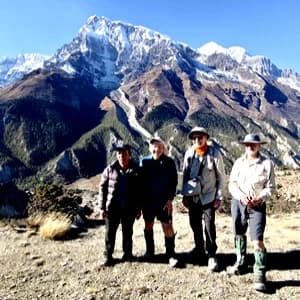
The 17 day Annapurna circuit trek – Outstanding expedition! I am more than pleased to have gone with Nepal Gateway Trekking to provide such an incredible...
